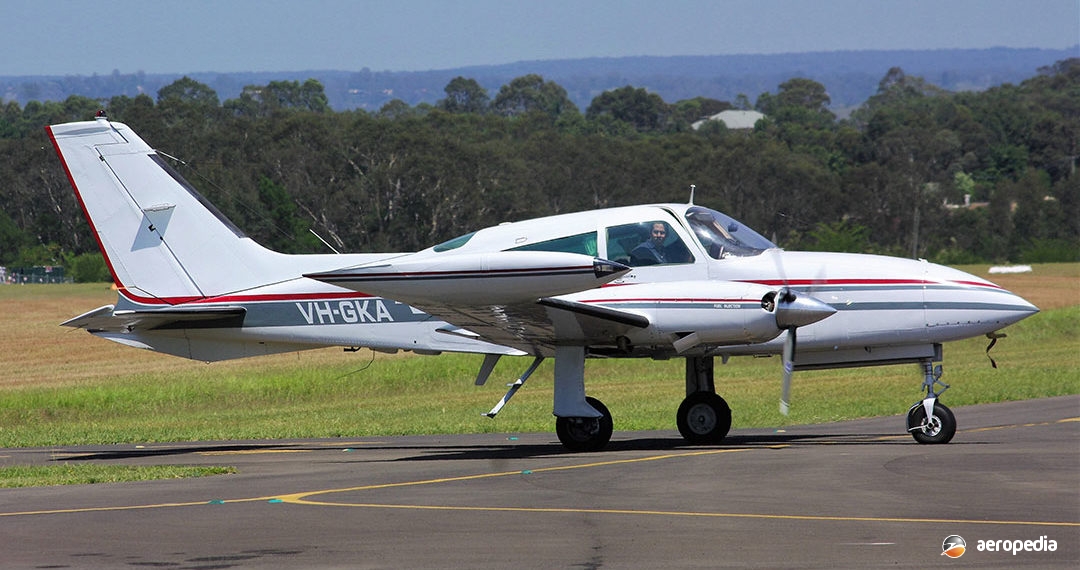Photograph:
Cessna T310R VH-GKA (c/n 310R1430) at Camden, NSW in January 2010 (David C Eyre)
Country of origin:
United States of America
Description:
Business and executive aircraft
Power Plant:
Two 194 kw (260 hp) Continental IO-470-V six-cylinder horizontally-opposed air-cooled engines
Specifications:
- Wingspan: 10.9 m (35 ft 9 in)
- Length: 9.02 m (29 ft 7 in)
- Height: 3.02 m (9 ft 11¼ in)
- Wing area: 16.2 m² (175 sq ft)
- Max speed at sea level: 390 km/h (242 mph)
- Max cruising speed at 2440 m (8,000 ft): 354 km/h (220 mph)
- Economical cruising speed: 275 km/h (171 mph)
- Stalling speed: 119 km/h (74 mph)
- Rate of climb at sea level: 550 m/min (1,800 ft/min)
- Service ceiling: 6,490 m (21,300 ft)
- Max range at 275 km/h (171 mph) at 3,050 m (10,000 ft) with auxiliary tanks: 2,320 km (1,440 miles)
- Empty weight: 1,378 kg (3,037 lb)
- Loaded weight: 2,190 kg (4,830 lb)
History:
Production deliveries of the Cessna 310 series of light, twin-engine, executive aircraft commenced in 1954 from the Cessna Aircraft Company plant at Wichita, Kansas, after the prototype had been flown for the first time on 3 January of the previous year. As with other Cessnas, model changes were denoted by the addition of a letter to the type number. However, this system did not come into operation until 1957, so all models built between 1954 and 1957 did not have a suffix letter. From 1958 until 1971, each model was identified, beginning with the Model 310B and continuing through, although the Models 310E and 310M were not built in volume.
Early models up to 1960 had the square-shaped dorsal fin, whereas later models from the Model 310D onwards featured the more modern swept tail that became the vogue throughout the Cessna range at that time. Up to 1958, all models had the 179 kw (240 hp) Continental engine, but the 1959 model was fitted with the 194 kw (260 hp) fuel-injected Continental.
The first major external change, ie extra windows, was made in 1956. Further windows were fitted in the 1961 Model 310F. In 1962 the Model 310G appeared with the wingtip fuel tanks canted upwards; and the Model 310I introduced baggage compartments at the rear of the engine nacelles.
Development continued. Later models featured a larger windshield, and the Model 310R introduced a stepped-down rear fuselage to permit a window to be fitted at the back of the cabin to increase rearward vision. At this time the nose was extended by some 81.3 cm (32 in) to allow for baggage space with a limit of 159 kg (350 lb), and extra avionics. Fuel capacity was increased, with the optional maximum being 783 litres (172 Imp gals). Power was increased by the installation of 213 kw (285 hp) Continental IO-520-M engines.
More than 150 examples have been registered in this region over the years. Total production of the Models 310 and 320 series up to 1980, when production ceased, was 6,013 aircraft, of which 196 aircraft were supplied to the US military services.
One of the first of the type to be seen in this region, a Model 310C, was ZK-BSY which arrived in Australia in August 1957 via New Zealand. This aircraft, fitted with a 189 litre (41.6 Imp gal) fuselage tank made the journey from Norfolk Island to Sydney airport, NSW (1,680 km -1,043 miles) in 6 hrs 5 mins. This aircraft became VH-UAL (c/n 35537) with the Utah Construction Company, later becoming VH-PRC.
At that time Rex Aviation of Bankstown, NSW was the Australian Cessna dealer and imported two Model 310Bs for the CSIRO, these becoming VH-REK (c/n 35583) and VH-REL (c/n 35590). These two aircraft were ferried from Oakland, USA to Australia, a distance of 16,383 km (10,180 miles) in 61 hrs 35 mins. VH-REK has survivd as part of the fleet of aircraft at the Historical Aircraft Restoration Society (HARS) at Albion Park, NSW.
Many were the uses for the type. Search and Rescue Australia (SAR) of Merimbula, NSW developed a Precision Aerial Delivery System (PADS) in the 1990s which was demonstrated to a number of authorities in south east Asia, the system dropping canisters or storpedoes which contained a marine pump, a six person liferaft, medical supplies, food, water and other equipment for survival at sea. The company’s Cessna 310R VH-FFA (c/n 310R-1212) was used in the test demonstrations.
Many were used on bank runs, by charter operators, and by companies such as McAlister Airways.
A number of Cessna 310s remain on the Australian Civil Aircraft Register and one Model 310P remains on the New Zealand Register.

